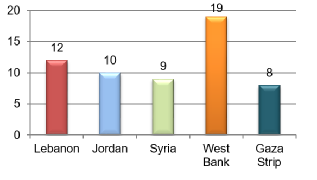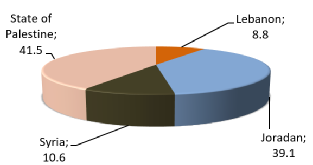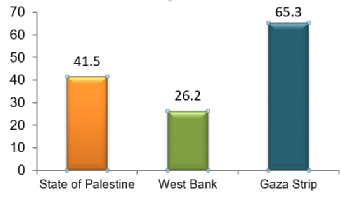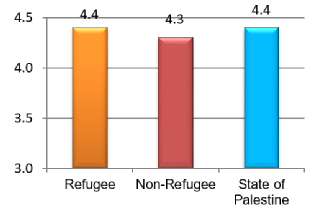

|
|
|
|
|
|
|
|
|
|
|
|
|
|
|
Payments to Jailed Palestinians and ‘Martyrs’ by the Palestinian AuthorityP |
|
|
|
|
|
|
|
|

|
PART 1 T O P I C |
|
|
|
|
|
|
|
|
|
|
|
|
|
|
|
|
|
|
JewishWikipedia.info
THE
INCREDIBLE
STORY OF THE JEWISH PEOPLE
WORLD FOOD PROGRAMME - PALESTINE
PALESTINE (2019)
WFP Palestine Country Brief, September 2019 (.pdf printout)
(Editors NOTE : This food tragedy refers to the majority of the population -
it does not refer to their leadership)
315,757 People Assisted in September 2019
US $2.7million distributed through cash based transfers, 1.4mt of food distributed,
US$17.8 million net funding requirements (November 2019-April 2020
In Palestine, ongoing protracted conflict, economic stagnation, restricted trade and access to resources, coupled with high unemployment and poverty rates, continue to pose serious challenges to the achievement of Sustainable Development Goal 2 on Zero Hunger, food security and improved nutrition.
Every day too many men and women across the globe struggle to feed their children a nutritious meal. In a world where we produce enough food to feed everyone, 821 million people – one in nine – still go to bed on an empty stomach each night. Even more – one in three – suffer from some form of malnutrition.
Eradicating hunger and malnutrition is one of the great challenges of our time. Not only do the consequences of not enough – or the wrong – food cause suffering and poor health, they also slow progress in many other areas of development like education and employment.
In 2015 the global community adopted the 17 Global Goals for Sustainable Development to improve people’s lives by 2030. Goal 2 – Zero Hunger – pledges to end hunger, achieve food security, improve nutrition and promote sustainable agriculture, and is the priority of the World Food Programme.
With nearly one third of the population – 32.7 percent, or 1.6 million people – not having the means to afford nutritious food, humanitarian assistance has prevented the food security situation from deteriorating further. Food insecurity is high among women – 32 percent of families headed by women are food insecure – and particularly in the Gaza Strip, where it peaks at 54 percent.
Poorly diversified diets are causing overlapping nutritional problems. According to the most recent national surveys, nearly 50 percent of those assessed had very low levels of essential minerals and vitamins.
The humanitarian conditions in Gaza – where poverty and food insecurity affect 53 percent and 68.5 of the population respectively– continue to deteriorate at an alarming pace following the collapse of all productive sectors, basic social services and infrastructures. Gaza’s socio-economic fabric is faltering due to the cumulative impact of 11 years of sea, land and air blockade and a year-long energy crisis which leaves residents with less than four hours of electricity per day.
The World Food Programme (WFP) has been in Palestine since 1991, providing food assistance to the most vulnerable non-refugee populations. WFP focuses its activities on areas with a high prevalence of food insecurity, including the Gaza Strip, where WFP has been expanding the use of cash assistance to support an ailing economy and increase the impact on the food security of the people it serves.
PALESTINIAN REFUGEES: PROTECTION IN EXILE
Topical Review Digest, Human Rights in the Middle East & North Africa, Vivienne Chew
The exact number of Palestinians in exile is unknown, with wide-ranging and contentious estimates by Palestinian and Israeli sources. Reasons for the difficulty in obtaining authoritative statistics on the Palestinian refugee population include frequent migration, the absence of a reliable census or a formal registration system, and the lack of an official definition of who constitutes a Palestinian refugee. Although UNRWA has adopted an operational definition of a Palestinian refugee, this simply establishes criteria for assistance and excludes large segments of the Palestinian refugee population. Therefore, even within the Operation Areas, the actual number of Palestinian refugees is unknown and could be much higher than the number of registered refugees. On the other hand, UNRWA’s statistics have been criticized as being grossly exaggerated, due partly to the agency’s failure to consistently update its registration lists.
Conclusion – The Future of Palestinian Refugees
Protracted exile has had a profound impact on the Palestinian refugee community. At the same
time, increasing radicalization among refugees and the rise of militarized opposition groups have severely affected peace and stability in the Middle East. Given the political impasse of the IsraeliPalestinian conflict, a solution to their displacement appears unlikely in the near future.
One of the fundamental obstacles in the peace process is the issue of the Palestinian right of return. For many Palestinians, this right is central to ending their displacement and statelessness; the right of return, whether exercised or not, together with appropriate compensation, lies at the heart of the Palestinian struggle. For Israelis, however, the return of a large Palestinian population could pose serious threats to Israel’s geopolitical and socioeconomic security and stability, and undermine the Jewish character and viability of the Israeli state. The call for a right of return is also seen by Israelis to stand in direct contradiction to the principle of a two-state solution. (Editors Note: The Palestinian demand is based on their education. It is seen by their leadership as something Israel will never accept and so the failure of negotiations can always be blamed on Israel. For the leadership, acceptnce may effect their position of power.)
PALESTINIAN POPULATION
TO PASS JEWS BY 2017 IN ISRAEL AND TERRITORIES
Forward, by Haaretz, Jan 2 2018
The number of Palestinians in Israel and the occupied territories will equal the number of Jews by the end of 2017, according to a report issued by the Palestinian Central Bureau of Statics (PCBS.)
The number of Palestinians worldwide is currently estimated at 12.37 million, with 4.75 million living in the Gaza Strip and the West Bank (1.85 million and 2.9 million respectively,) 1.47 million in Israel, 5.46 million in Arab countries and some 685,000 in non-Arab countries.
The report puts the total number of Palestinians in what it calls “historical Palestine” (Israel, the West Bank and the Gaza Strip) at the end of 2015 at 6.22 million, compared to 6.34 million Jews.
But Palestinian birth rates of 4.1 in the occupied territories (during 2011-2013) and 3.2 in Israel proper (in 2014) – compared to a rate of 3.1 births among Israeli Jewish women – are expected to bring the populations to parity in 2017.
By the end of 2020, the report estimates, Palestinians in the entire territory will number 7.13 million, compared to 6.96 million Jews.
The Palestinian population within Israeli is particularly youthful, according to the report, with some 34.8% aged below the age of 15 years in 2014. Only 4.2% of the Palestinian population in Israel is aged 65 years and over.
The average household size of Palestinians in the occupied territories was 5.2 people in 2014, down from 6.1 in 2000. In Gaza, the size of the average household was 5.7 people, while in the West Bank it was 4.9. The average size of an Israeli household is 3.73 people, according to the Israeli Bureau of Statistics. read more: http://www.haaretz.com/israel-news/1.694819
INTERNATIONAL DAY OF REFUGEES, 20/06/2017)
Palestinian Central Bureau of Statistics (PCBS)
66% of Palestinians who were living in
Historic Palestine (British-Mandated Palestine) in 1948 were Expelled and Displaced
The human plight and tragedy that has befallen on the Palestinian people in 1948, a devastating tragedy was expelled and displaced from land seized by Israeli occupation as about 957 thousand Palestinian Arabs, representing 66.0% of the total Palestinians who were living in historic Palestine on the eve of the war of 1948, according to estimates in 1950.

Number of Official Palestinian Camps
as Recognized by UNRWA by the Residential Country
Source: General Statistics UNRWA Statistics Bulletin-2016(11 May 2017)
Several official estimates on the number of Palestinian refugees on the eve of the 1948 war were released from various sources. However, United Nations released two estimates: the first referred to the number of Palestinian refugees that amounted to about 726 thousand refugees as based on the estimates of the United Nations in 1949. And the second that amounted to 957 thousand refugees as based on estimates of 1950.
UNRWA Records indicated that the number of registered Palestinian refugees in 2016 amounted up to about 5.9 million and these figures represented the minimum number of Palestinian refugees. Palestinian refugees in the West Bank who are registered with UNRWA as in 2016 accounted up to 17.0% of the total refugees registered with UNRWA against 24.5% in Gaza Strip. At the level of the Arab countries, the percentage of Palestinian refugees registered with UNRWA in Jordan, amounted up to 39.1% of the total Palestinian refugees while the percentage of Palestinian refugees registered with UNRWA in Lebanon and Syria reached 8.8% and 10.6% respectively.

Percentage Distribution of Palestinian Refugees by the Residential Country 2016,
(According to the data of UNRWA on the Palestinian Refugees)
Source: General Statistics UNRWA Statistics Bulletin -2016 (11 May 2017)
Data refer that the percentage of the population of refugees in State of Palestine in 2016 is estimated at 41.5% of the total Palestinian population living in State of Palestine, and data indicated that 26.2% of the population in the West Bank are refugees, while the percentage of refugees in Gaza Strip is 65.3%.

Percentage of Refugees
in State of Palestine by Region, 2016
Source: Palestinian Central Bureau of Statistics 2017. Database of the Labor Force Survey, the fourth quarter 2016. Ramallah -Palestine
The percentage of persons aged less than 15 years in State of Palestine reached 39.1% (as of 39.3% for refugees and 38.9% for non- refugees) in the fourth quarter 2016, while the percentage of elderly aged 60 years and over among refugee reached 4.2% of the total refugees while for non- refugees reached 4.8%.
The total fertility rate for the period (2008-2009) in State of Palestine amounted 4.4 births. When compared to those rates by refugee status, it is clear to us that there are light differences in the total fertility rates between refugees and non-refugees, the total fertility rate among refugee reached 4.4 births while these rates among non-refugee reached 4.3 births.

Fertility Rates in State of Palestine by refugee Status (2008 -2009)
Source: Palestinian Central Bureau of Statistics, 2017. Palestinian family Survey Database, 2010.
Ramallah –Palestine
PARTICIPATION RATE IN LABOR FORCE IS LOW FOR BOTH REFUGEES AND NON-REFUGEES
The results of the Labor Force Survey in 2016 showed that the participation rate in labor force among refugees aged 15 years and over whom residing in State of Palestine were 46.1% against 45.5% for non- refugees.
UNEMPLOYMENT RATE IS HIGH FOR REFUGEES
Data indicated that there is a clear difference on the level of unemployment rate among refugees and non-refugees, as unemployment rate among refugees reached up to 33.3% compared to 22.3% among non-refugees.
ONE-THIRD OF THE REFUGEES ARE WORKING AS SPECIALISTS AND TECHNICIANS
In 2016, the profession of "technicians, specialists, assistant, and clerks" considered as the most accommodating profession among refugees and non- refugees in State of Palestine alike as refugees amounted to 33.8% while the non-refugees reached 22.9%. Also, legislators and senior management staff represented the lowest percentage for both of refugees and non-refugees with a variation by 3.0% for refugees and 3.3% for non-refugees.
AN INCREASE IN PERCENTAGES OF EDUCATIONAL ATTAINMENT AMONG REFUGEES
The percentage of illiteracy among Palestinian refugees in 2016 for individuals aged 15 years and over reached 2.7%, while among non-refugee reached 3.3%. As a percentage of Palestinian refugees aged 15 years and over who obtained a bachelor's degree or higher reached 14.9 % of the total refugees aged 15 years and over against 12.6% for non-refugees.
ABOUT 65% OF THE REFUGEE HOUSEHOLDS LIVE IN AN APARTMENT
Data of 2016 indicated that 43.3% of the households of State of Palestine live in an independent house, the percentage among non-refugee was 50.2% against 34.1% for refugees, and the percentage of household living in an apartment reached 54.4% (46.4% non-refugee against 65.2% for refugee). The percentage of refugee households living in a rented accommodation reached 10.6% of the total refugee households and 72.1% for refugee households are living in owned housing unit.
THE SITUATION OF PALESTINIANS REFUGEES IN DIASPORA:
Palestinians refugees in Jordan
The socio-economic conditions of the Jordan's Palestinian camp refugees study 2011, which prepared by FAFO shows that 39.9% of persons in the Palestinian camps refugees in Jordan aged under 15 year old , while the percentage of elderly (65 years and over) was 4.3%, and the average of household size was 5.1 persons. The data also indicated that the percentage of illiteracy rate among the Palestinian camps refugees in Jordan aged 15 and over was 8.6%.
Palestinians refugees in Lebanon
Data available on Palestinians living in Lebanon in 2011 showed that 31.1% of the population were below the age of 15, 6.1% were aged 65 years and over. The sex ratio was 98.2 males per hundred females in 2011. Data available for 2011 indicated that the average Palestinian household size was 4.4 persons, the total fertility rate was 2.8 births per woman, the infant mortality rate was 15.0 per thousand live births and the mortality rate for children below the age of five was 17.0 per thousand live births in the same year.
Analysis: How many Palestinians are there in the West Bank? It depends. I24 Israel
Lebanon Census Finds Number of Palestinian Refugees Only a Third of Official UN Data
Haaretz, Amira Hass Dec 25, 2017
A census in Lebanon finds 175,000 Palestinian refugees living in the country, while the UN figure put their number at 500,000
|
DID ISRAEL - UNRWA, formed in 1948 to look after Palestinian refugees UNHCR formed in 1949 to look after refugees from the rest of the world The Palestinian refugees are the only group of refugees 'Palestine Refugee’ became a ‘heritable status’ by UNRWA in 1965. Other Refugees do NOT have a ‘heritable status’ with UNHCR |
|
|
|
|
|
ORIGINAL PALESTINIAN REFUGEES |
|
|
1948 Arab Palestinians exodus: (Most of them became Palestinian refugees |
711,000 (estimated) |
|
1948 Palestinian refugees still alive in 2012: |
30,000 to 50,000 (estimated) |
|
1967 Palestinian refugees exodus:[4] |
280,000 to 325,000 (estimated) |
|
Descendants (2012): |
4,950,000 |
|
PALESTINE AND PALESTINIAN REFUGEES UNDER UNRWA MANDATE |
|
|
Total (2015) |
5,149,742 |
|
Regions of operation |
Gaza Strip, West Bank, Lebanon, Syria, Jordan |
|
Non-registered 1948 refugees |
Estimate (2015 Assumes approximately one-quarter of 1948 refugees are unregistered |
|
PALESTINE AND PALESTINIAN REFUGEES UNDER UNHCR MANDATE |
|
|
Total 2014 |
97,212 |
|
Regions with significant populations:[6] |
Gulf States, Egypt, Iraq, Yemen, as well as Australia, Europe and America |
|
|
|
|
GROWTH RATES The growth rates show the major annual increase in (All figures approximate) FIGURES BELOW BASED ON WIKIPEDIA FIGURES IN TABLE ABOVE |
|
|
Palestinian UNRWA Registered Refugees in 1948 |
711,000 |
|
In 2015 this became, |
5,149,742 |
|
So, in 2082 i.e. in 67 years time, this will become THE TOTAL NUMBER WILL BE FAR HIGHER IF THOSE WHO CAN CLASSIFY THEMSELVES AS PALESTINIAN REFUGEES, BUT ARE NOT REGISTERED WITH UNRWA |
37,284,000 = 556,477 per year
|
|
|
|
|
Example of Area Growth |
|
|
October 2015, |
This will grow 7.24 times |
|
Gaza Annual Growth Rate |
121,075 refugees (9,412,000 - 1,300,000 = 8,112,000 divided by 67) |
|
Example of Donor Contributions |
|
|
US, = $380,593,116 (No.1) |
Top 3 contributors 49% of Total Donor contributions |
|
Two examples of how information is expressed are: The Independent, a special report by Judith Miller and David Samuels Wednesday 21 October 2009 It is a cynical but time-honoured practice in Middle Eastern politics: the statesmen who decry the political and humanitarian crisis of the approximately 3.9 million Palestinians in the Israeli-occupied West Bank and in Gaza ignore the plight of an estimated 4.6 million Palestinians who live in Arab countries. For decades, Arab governments have justified their decision to maintain millions of stateless Palestinians as refugees in squalid camps as a means of applying pressure to Israel. The refugee problem will be solved, they say, when Israel agrees to let the Palestinians have their own state. fanack, Chronicle of the Middle East and North Africa October 2010, Published December 2016 According to the Palestinian Central Bureau of Statistics (PCBS), there were 10.97 million Palestinians worldwide in 2010. 4.11 million Palestinians were living in Palestine (37.5 percent); 1.36 million (12.4 percent) in Israel; 3.24 million (29.8 percent) in Jordan; 1.78 (16.3 percent) in the other Arab countries, especially in neighbouring Lebanon and Syria; and 626,800 (5.7 percent) in the rest of the world. |
|

PALESTINIAN REFUGEE STATISTICS
|
Palestinian Population To Pass Jews by 2017 in Israel and Territories |
